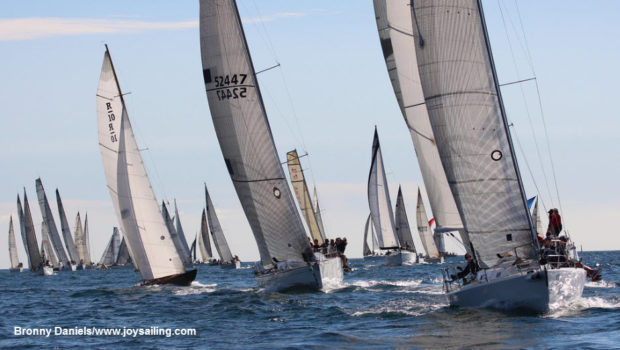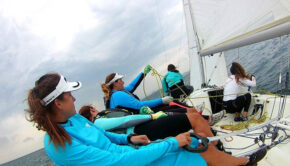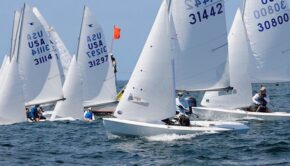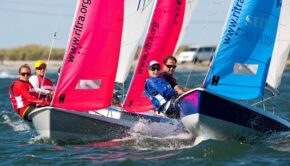Dividing the PHRF Fleet
Published on February 15th, 2017
It’s typical for one design regattas to require a minimum number of boats for a class to compete. Sometimes its three boats. Sometimes its five boats. The requirement helps to justify the effort on the event side and to ensure decent competition for the participants. Makes sense.
But what about handicap events?
All rating systems work best when boats are grouped not only by a narrow rating band (span from fastest to slowest boat), but also when the boats have similar hull form, weight, length, etc. This helps to keep boat performance consistent through the fleet in all wind and wave conditions. But how is this done when the entries for an event don’t fit well into categories?
With the great disparity of boat design now on the race course, a PHRF event can bring together boats of a wide range. Using San Diego PHRF ratings, a speedy Melges 32 is just three seconds a mile different on a buoy course than a cruisy Beneteau 44.7M. Through the wind range, a single number system will struggle to give a sportboat and displacement boat fair buoy racing.
Assuming that displacement boats form the foundation of a PHRF event, how does an event organizer structure their event?
Here are two choices: gather all boat types and create rating bands based on the entries received, or separate the sportboats from the displacement boats and then divide into fleets based on their rating. One plan encourages participation at the possible expense of good racing while the other likely offers better racing by separating dissimilar boats, but may risk participation if sportboats are unable to form a fleet.
What is the best choice?
By including all boats, and splitting them up as fairly as possible, does that send a better message that participation is the priority? However, if the racing does not prove to be fair given the disparity in the boat types, does that ultimately impact participation and possible growth down the road?
Or is it better to separate the sportboats to protect what is likely a larger displacement fleet? The risk of this tactic is to either not have enough sportboats to form a fleet at all, or to have too wide a rating band to provide them fair racing.
Scuttlebutt hosted a survey on February 15-16 to ask what was the best choice. Here was the response:
74% – Separate sportboats from displacement boats, have a number of boats needed for each fleet, and divide the boats into rating bands given the entries received.
26% – Include all boat types and divide the fleet into rating bands given the entries received.
Some of the respondents provided comments. Here they are, unedited and grouped according to how they voted (each paragraph is one comment):
Include all boat types together.
I have just proposed to our Nova Scotia handicap (PHRF TOT) committee a 3 tier system of rating the fleet. The TOD numbers stay the same but the formula, in particular the B factor, is different for the three fleets. Our fleet ranges from -6 to about 240 and a single conversion formula simply can’t cope fairly with such a huge spread. Unfortunately, as in many places, the committee is stuck in the past and likely will reject my proposal….this is to bad because fleet sizes have shrunk to an all-time low and trying something new and demonstrably fairer might encourage more participation. Fingers crossed.
The best scenario is a compromise. Separate the sport boats and ULDBs from the displacement boats if the numbers warrant it. If there aren’t enough sporty boats to form a division (usually 5 boats), combine them with their heavier counterparts and divide them all by rating band. Some club races are so small that they are divided simply into Spinnaker and Non-Spinnaker divisions.
I prefer separating sport boats, sprit boats and symmetrical spin displacement boats into their own fleets, but most of the time there aren’t enough boats to do that, so than I just go with the best rating bands.
Actually, a blend of the two works well. The deciding factor is the number of boats – both in the various sizes and types and the overall fleet. If there are only a dozen boats for the whole regatta, start ’em all at one time. If you’ve got a couple hundred, start the boats in narrow rating bands and base the class on type. In the Pacific Northwest Swiftsure breaks the classes up by boat displacement. It seems to work for the larger regatta. What this really is about is amount of participation. Our sport is shrinking for a variety of reasons and we’re not doing much to bolster participation. Get more boats on the water and this problem will solve itself.
On Long Island Sound, the larger displacement boats usually perform better in the typically lighter breeze seen during July and August. They are able to finish a race before winds die on a Tuesday or Wednesday night beer can race. When the breeze is up (spring and fall and roughly 15% of the time during the dog days of summer), smaller, lighter performance boats have their time to shine and you’ll see J/70s and J/24s finishing at the top of the leaderboard. Each boat type eventually finds conditions favorable to them and can do well. Keep the fleets together and separate by ratings bands to keep the starts fun and mix the racing up.
If you have sufficient entries, take D/L or SA/D ratio into account. If you have a weak turnout, sail everyone together.
There are not many sport boats in our area, and even well prepared boats tend to be older designs. I long ago accepted that certain boats will have advantages in their optimum conditions, and I would rather see better participation to justify the race committee effort by the organizers.
I have a 25 foot sport boat and in my experience, there are never enough sport boats to form a separate fleet. If there are, the organizing authority often categorizes some boats as sport boats that do not really qualify as one or places 25 foot sport boats with 30 foot or 35 foot boats, which is not fair either.
Try listing all the entries as they come in on a page everyone can see. Then try letting the boat owners or captains choose what class or group of boats they wish to sail against or feel is the correct class for their boat.
Given the very wide range of boats on the market events should be available for all to take part & have the opportunity to meet the whole sailing community.
We try to use PHRF ratings to group boats by their rating – a group under PHRF 200 and a group over. Our small daily weather window (we start multiple fleets when necessary) and the lack of sportboats allow this to work for our entrants.
Include all. If there are enough boats to divide out sportboats then great divide them out, but generally in a small enough regatta where there may not be enough boats to make a fleet the boats that do show up are there to enjoy some sailing, not nitpick ratings so let everyone sail. Discouraging participation doesn’t help the sport.
Separate sportboats from displacement boats.
No question here. Sport boats have a distinct advantage over Furniture boats mostly due to weight. Especially in an area such as San Diego with light air on most days. ( 75 Racers – DWSA/DISP 50 to 75 Racer Cruises – DWSA/DISP < 50 Cruisers – ASYMCL, Roller Furler Main DWSA/DISP
Sport boats are simply far too different from displacement boats to be in the same fleet. They need their own rating band.
Having raced a Corsair F-27 tri in PHRF in FL, GA, AL, IL, and New England I can say that racing against another PHRF 48 rated monohull would not be fair…we will generally sail circles around the mono. And the same applies to, say, a J-35 versus a Melges 30…just not apples to oranges. Having said that, it is important for race organizers to focus on soliciting entries in each proposed division to have adequate entries. Collapsing entry classes at the last minute isn’t fair in most cases. It really all comes down to having participants who will “cheer lead” their class to get entries to the starting line among their PHRF peers. It takes work. It takes commitment. But everyone wins with bigger turnouts.
The problem is defining a sport boat. For example is a King 40 a sport boat or a displacement boat?
I own a displacement boat (C&C 36 XL/kcb) and unless the course is long and/or the wind is 12+, most sport boats with PHRF ratings are strongly favored in any race split by PHRF ratings only. Sport boats, especially if conditions allow them to plane, racing in a PHRF fleet is like racing road bikes against trail bikes, sprinters vs milers, thoroughbreds vs. draft horses, greyhounds vs. retrievers, etc. Why race organizers can’t ‘get’ that differences like these make almost all races that base fleets solely on PHRF unfair ‘out of the gate’ is beyond my understanding. In an effort to ‘increase participation’ and get ‘lots of boats on the starting line’ (and crews at the socials!), the OA sacrifices fair racing for boat entries and more often than not satisfies neither the displacement racers or the sporting crowd. And if they do register, at least in my own case, I consider my competition to be the other displacement hulls on the course–not any sport boats whose rating happens to put them on my PHRF class. Unfortunately, this does not often get me any silver but close racing, against even one displacement boat with a similar PHRF keeps me coming back–silver or not! If the ‘…wind is right…’ and the waves are up, I might get lucky and correct over a sport boat. However, both he/she and I know that the course presented a unique (and very rare) combination of the wind and waves that pushed my 13500 pound displacement hull ahead of his 2000 pound sport hull. Unfortunately many other displacement hull PHRF racers have apparently seen the light and abandoned racing in such fleets to the detriment of fun club racing and the sport of sailing.
I would think that the sport boat sailors would generally be a keener racing crew and would rather race more of the same competition.
Sportboats vs. displacement boats simply do not equate to a fair test of sailing – period!
Depends a lot on format. Hot rum works over a longer span and different conditions from a weekend event. The best scenario would be to get owners of similar types and speeds to agree on a class and series that they want to participate in. IE, plastic classics, sportboat, racer cruiser between 60 and 99 rating, 40-50′ ims, etc.
As the article notes, sometimes there are not enough sportboats, or the sportboats entered have too great a rating disparity to provide fair handicap racing, but putting an ultralight sportboat up against a normal heavier displacement boat with similar ratings does not bode well for participation from older generation boats that would like to compete with a fair chance of doing well.
The ideal is the separation into groups that perform similarly in any one particular condition. But, when there aren’t enough boats, let’s figure out how everyone can get out and compete. Especially in lower level races. By that I mean local club races. Are we doing this for fun? Or is it only for trophies?
As a single number rating system or even a dual number rating system PHRF is limited in what it can accomplish. Rating bands or fleet splits might help but it is a system that relies on the “every dog has its day” theory and in the end is inherently rife with regional politics. PHRF is trying to do more then originally designed and is pushing many people out of big boat racing. Great for Wednesday nights and for newcomers. Perhaps the time has come for a change. What we need is a inexpensive hybrid rule that combines the best of the measurement rules with an observed component factor. Inexpensive, has great flexibility for OA’s, has a regional rating component with National oversight.
Promotion is desperately lacking across the board. All sailors need to work to grow the fleet that is participating. A sportboat against a lead slug is never going to rate fairly.
Handicappers say that it is virtually impossible to fairly handicap a SB vs displacement hulls (at least without having a very specifically pre-defined course and pre-determined weather). You can’t encourage participation if the race isn’t as fair as possible. So split the types first, then the rating bands.
There is not a rating rule that can fairly rate sport boats vs. displacement boats. I have heard of cases where the fleet numbers are small, and the fleets are combined with poor satisfaction, usually resulting in diminished participation next year. Unfortunately, I feel that sailing has tipped over the edge into becoming an extreme sport. Sport boats and catamarans are the boat types that garner all of the attention and interest. Unfortunately, cats and sport boats are not attractive to the general sailing population: they are a blast to sail downwind, but what goes down must go back up(wind). Furthermore, sport boats and catamarans are not comfortable offshore boats, making long offshore races extinct for the average sailor. (I don’t think sailing a TP52 upwind in a long race is my idea of a good time.)
I view this as a false dilemma. It should be the responsibility of sailors to create fleets of handicapped boats against whom they wish to compete. We’ve done that on SF Bay with a few different fleets–find boats that race well against each other based on sail area, displacement, waterline length and design and self-organize a fleet. It’s better racing, it creates camaraderie and takes responsibility from the event organizer and places it squarely on the participants. It won’t happen overnight, and not every boat will find the right “fit,” but the sailors themselves must roll up their sleeves and work to make racing more fun or it will die off.
Neither choice is ideal. We see more conventional boats than sport boats at an average event. We prefer to give the majority ( ie the standard) boats a fair event. We figure if we group the sport boats together, that this will incentivize more sport boats to participate. We will race a class of sport boats if only three show up. Less than three is problematical. Eastern Connecticut.
Participation in handicap racing fleets in San Francisco Bay has fallen well below critical mass. So it really no longer matters. This poll is simply more fiddling while Rome has burned long ago. Racing displacement boats against sport boats under PHRF is a waste of time. Sport boats have long tended to be designed to take advantage of the rating systems anyway… whereas the older displacement boats are, in PHRF terms, obsolete. Go ahead and keep arguing the point from any theoretical point you care to. And there are lots of folks who still are true believers and will waste your time doing so. But don’t bother looking out the window to check actual turnouts. Even if it were theoretically accurate to say the ratings work, the PERCEPTION is now that they don’t. And perception is what matters. If you objective is to improve participation, a new ratings model and a new fleet designation model is required. But most organizations don’t have the stomach to do what it takes and are held prisoner of the PHRF traditionalists who favor the glories of a broken, obsolete racing model in the US. To challenge them is to invite endless offensive flame mail attacks, fleet bylaws fights, and patronizing lectures on the glories of PHRF. Which drive participation down further than getting beaten like a gong, race after race. We gave up hoping to find much if any competitive handicap racing that even faintly approximates one-design standards and means anything last year. Now we just cruise our boat and take part in such “fun” races as promise a good long course and a keg of beer at the end. We think of such races as racing yacht rallies rather than races that are fairly handicapped and meaningfully competitive.









 We’ll keep your information safe.
We’ll keep your information safe.